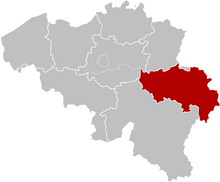Diocese of Liège
|
Diocese of Liège Dioecesis Leodiensis Diocèse de Liège (French) Bistum Lüttich (German) Bisdom Luik (Dutch) |
|
|---|---|

|
|
| Location | |
| Country | Belgium |
| Ecclesiastical province | Mechelen-Brussels |
| Metropolitan | Archdiocese of Mechelen-Brussels |
| Statistics | |
| Area | 3,862 km2 (1,491 sq mi) |
| Population - Total - Catholics |
(as of 2013) 1,054,000 721,000 (68.4%) |
| Information | |
| Denomination | Roman Catholic |
| Rite | Roman Rite |
| Cathedral | St Paul's Cathedral in Liège |
| Current leadership | |
| Pope | Francis |
| Bishop | Jean-Pierre Delville |
| Metropolitan Archbishop | Jozef De Kesel |
| Emeritus Bishops | Albert Jean Charles Ghislain Houssiau, Bishop Emeritus (1986-2001) Aloysius Jousten, Bishop Emeritus (2001-2013) |
| Map | |
 The Diocese of Liège, coextensive with the Province of Liège |
|
| Website | |
| Website of the Diocese | |
The Roman Catholic Diocese of Liège (Latin: Dioecesis Leodiensis) is a diocese of the Latin Rite of the Roman Catholic church in Belgium. The diocese was erected in the 4th century, and has a long and complicated history. Currently the diocese is a suffragan of the Archdiocese of Mechelen-Brussels. Its modern version covers the same territory as the Belgian province of Liège, but it was historically much larger.
The original diocese was the church equivalent of the Civitas Tungrorum, the capital of which was Tongeren, northwest of Liège, and its borders were probably approximately the same.
The bishopric of Tongeren originally formed part of the dioceses of Trier and Cologne. After the first half of the fourth century, the bishopric of Tongeren received autonomous organization. In late antiquity, the centre of administration and religion in the area moved first to Maastricht, and then to Liège.
The boundaries were formed, to the North, by the diocese of Utrecht; to the East, Cologne; to the South, the dioceses of Trier and Reims; to the West, that of Cambrai. Thus the diocese of Tongeren extended from France, in the neighbourhood of Chimay, to Stavelot, Aachen, Gladbach, and Venlo, and from the banks of the Semois as far as Ekeren, near Antwerp, to the middle of the Isle of Tholen and beyond Moerdijk, so that it included both Romance and Germanic populations. The boundaries remained virtually unchanged until 1559.
...
Wikipedia
